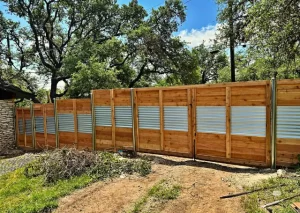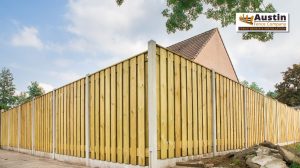
Table of Contents
ToggleTL;DR
If your fence shows minor damage such as loose boards, minor rust, or slight leaning, repair is often the most cost-effective solution. However, if there’s extensive structural damage, widespread rot, or your fence no longer meets your needs, replacement is the smarter investment. Costs vary by material, labor, and scope—repairs typically range from $150 to $900, while complete replacement can cost $1,500 to $8,000 or more.
Table of Contents
Understanding the Factors That Influence the Decision
Deciding between repairing and replacing your fence isn’t just about cost—it’s about functionality, aesthetics, and long-term durability. Homeowners in Austin must also consider local weather conditions, HOA requirements, and the impact these factors have on property value. A fence that looks fine today might be hiding deeper problems, such as compromised posts or termite damage.

Key factors include:
- The age of the fence: Most wood fences last 15–20 years with proper maintenance; metal and vinyl fences can last longer.
- Extent of damage: Is it isolated to a small section or spread across multiple areas?
- Material type: Different materials age and degrade in unique ways.
- Budget and long-term plans: Sometimes, investing more upfront can save money over time.
When Fence Repair Makes Sense
Repair is ideal when the structural integrity of the fence is mainly intact. For example:
- Loose or missing boards/panels: Common in wood fences due to weather expansion and contraction.
- Minor leaning: Often caused by loose posts that can be reinforced.
- Localized rust or corrosion: Can be removed and treated without replacing entire sections.
- Gate misalignment: This is usually corrected by adjusting the hinges or latches.
Repairs can extend your fence’s life by several years, delaying the cost of full replacement. This is especially valuable if you plan to renovate or sell your home shortly and want to maintain curb appeal without overspending.
When Fence Replacement Is the Better Choice
Full replacement is often the better investment if your fence has reached the end of its useful life or if repairs would be frequent and costly. Signs it’s time for replacement include:
- Widespread rot or termite damage in wooden fences.
- Severe leaning caused by multiple compromised posts.
- Multiple broken panels in vinyl or composite fencing.
- Persistent rust or sagging in chain link or iron fences.
- Major design upgrades are needed to improve aesthetics, privacy, or security.
Replacement also allows you to upgrade materials for improved durability—switching from wood to composite or vinyl, for instance, can reduce long-term maintenance costs.
Cost Breakdown: Repair vs. Replacement
While exact costs vary based on location, material, and labor, here’s a general comparison:

Average Fence Repair Costs in Austin:
- Minor fixes (1–2 boards or panels): $150–$350
- Post replacement: $200–$500 each
- Gate repair: $150–$400
- Rust treatment/repainting: $200–$600
Average Fence Replacement Costs in Austin:
- Wood (privacy): $1,800–$4,000
- Vinyl: $3,000–$7,000
- Wrought iron: $3,500–$8,000+
- Chain link: $1,500–$3,500
While repair may seem cheaper initially, frequent repairs can quickly add up—especially for older fences near the end of their lifespan.
How to Evaluate Your Fence’s Condition
A thorough evaluation should include:
- Post stability: Check for wobbling or leaning.
- Material integrity: Look for signs of rot, rust, or warping.
- Hardware function: Ensure hinges, latches, and fasteners are intact.
- Alignment: Sight down the length of the fence for warping or uneven sections.
- Surface protection: Check if the stain, paint, or protective coating is intact.
Hiring a professional inspector provides you with a detailed condition report, helping you make an informed decision.
Expert Tips for Extending Fence Lifespan

Regardless of whether you repair or replace your fence, proactive maintenance can significantly extend its life:
- Regular cleaning: Remove dirt, mold, and mildew on an annual basis.
- Reapply protective coatings: Stain or seal wood fences every 2–3 years to maintain their appearance.
- Prompt Repairs: Address minor damage promptly to prevent it from escalating.
- Trim vegetation: Prevent plants from trapping moisture against the fence.
- Seasonal checks: Inspect after storms or high winds for hidden damage.
Frequently Asked Questions
At least twice a year—once in spring and once before winter—to catch issues early.
If the damage is localized and the rest of the fence is structurally sound, replacing panels can be a cost-effective solution.
Yes—especially if it improves curb appeal, security, or privacy.
Yes, but for aesthetics and resale value, it’s best to match the same materials and color.
Typically 2–5 days depending on size, material, and weather conditions.
Making the Smart Choice for Your Property
Whether you choose repair or replacement, the right decision balances your budget, property goals, and long-term maintenance needs. For many Austin homeowners, repairing can buy valuable time, while replacement offers a fresh start with modern, durable materials. By assessing your fence’s condition and factoring in both costs and plans, you’ll ensure your property stays secure, attractive, and functional for years to come.
If you need expert advice or a professional inspection, working with a trusted local fencing company ensures you make the best decision for your home.
